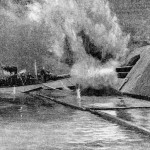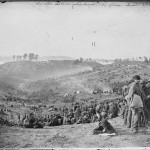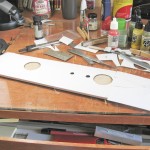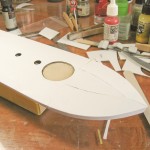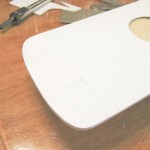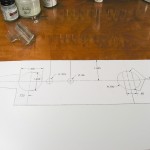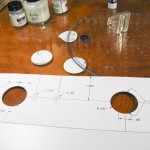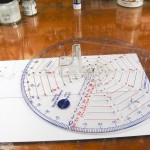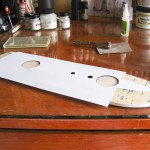My second piece for the Times’ “Disunion” web series has been published. “Rise of the Infernal Machines” gives an overview of the torpedoes of the day, what we now mostly know as mines. Crude, unstable, and mostly non-functional, they provided the Confederacy with a new weapon with which to strike back at the superior Union navy. Despite their endless problems, they succeeded in sinking more Union warships than all other means combined (probably speaking more to the ineffectiveness of Confederate warships and fortifications than to effectiveness of the torpedoes). The article can be access HERE.
Playing Cards and Running
January 1863 saw the 19th Indiana and the Iron Brigade in winter quarters, camped at Bella Plain, VA, on Potomac Creek. Still smarting from the defeat at Fredericksburg, many referred to the winter of 1862-1863 as “the Valley Forge of the Army of the Potomac”. The soldiers built wooden cabins that they fitted with fireplaces and covered with their field tents, then settled in for several months of inaction.
With little to do, talk among the soldiers turned to the recent Emancipation Proclamation. Most were against it, in the respect that they thought it changed the course of the fight. A Captain of the 19th wrote “I dont want to fight to free the Darkeys. If any body else wants to do so, they are welcome to come and do so.”(sic) The near-general consensus throughout the unit and most of the army was that they had signed up to restore and preserve the Union, not free slaves. Obviously little thought was given to the main reason that had caused the war and brought them to that place. Still, others welcomed the proclamation and couldn’t wait to get freedmen Continue reading
New York Times “Disunion” Piece Published
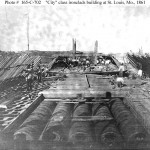 Very happy to announce that the New York Times has published my first piece for their website. Ironclad Fever is about the armored warship building frenzy in both North and South after the Monitor and Virginia (Merrimack) battle in 1862.
Very happy to announce that the New York Times has published my first piece for their website. Ironclad Fever is about the armored warship building frenzy in both North and South after the Monitor and Virginia (Merrimack) battle in 1862.
I’m extremely pleased to be able to put all of the historical research I’ve done while building models and writing stories into this format.
Giving it the sidelong glance
I recently acquired a copy of Ken Rand’s “The 10% Solution” and ran a couple of pieces of writing through the process. The premise is simple: nearly everyone can run through a piece of work and cut it by 10%, in the process making it sharper, more concise, and easier to understand.
The first revelation is that I had no idea how often I use “of” in my writing. I mean a lot. A whole bunch of “ofs”. That and the always prevelant “and”, “was”, and “were” jumped out at me as I ran through the process in the book. The interesting bit came when the process didn’t simply result in deleting words, but recasting entire sentences and paragraphs when those issues are called to attention, and how the resulting product is so much the better.
I’ve always taken the “walk away” approach to writing and other projects — Continue reading
150 Years Ago Today: USS Cairo, Preserved by Gunpowder
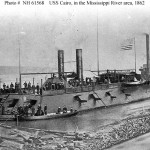 “…I heard an explosion from the Cairo, and on looking up (from a small boat on the river) I saw her anchor thrown up several feet in the air.” – Ensign Walter E.H. Fentress
“…I heard an explosion from the Cairo, and on looking up (from a small boat on the river) I saw her anchor thrown up several feet in the air.” – Ensign Walter E.H. Fentress
“…just as we were training on the battery (gun emplacement or torpedo), we were struck by a torpedo, which exploded under our starboard bow, a few feet from the center and some 35 or 40 feet from the bow proper just under our provision store room, which crushed in the bottom of the boat so that the water rushed in like the roar of Niagara. In five minutes the Hold was full of water and the forward part of the gunboat was flooded… One of our heaviest bow guns had been dismounted by the force of the explosion, injuring three men. ” -George Yost.
On December 12th, 1862, the American Civil War saw yet another military first: USS Cairo became the first warship sunk by an underwater mine, or torpedo as they were known at the time. The Union Navy had known of Continue reading
After Antietam: Regrouping
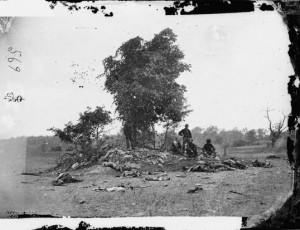 After the Battle of Antietam, the Union Army took time to lick its wounds. President Lincoln and many in the Washington command structure champed at the bit and wanted McClellan and the army in pursuit of the Confederates to follow up on the victory. McClellan, though, stood by his decision to rest his battered forces and regroup.
After the Battle of Antietam, the Union Army took time to lick its wounds. President Lincoln and many in the Washington command structure champed at the bit and wanted McClellan and the army in pursuit of the Confederates to follow up on the victory. McClellan, though, stood by his decision to rest his battered forces and regroup.
The men of the 19th Indiana and the Iron Brigade rejoiced at the break. They’d been roughly handled in their first three battles, and their numbers depleted drastically. Immediately after the battle the unit camped on the battlefield near the Dunker Church, their objective the morning of the battle. As the fortunate began to trickle in from the hospital, the survivors walked the fields, burying the dead men and feeding huge bonfires to burn the dead horses and mules; inky black smoke towered skywards for weeks afterwards while Gardner’s photographers walked the battlefield and photographed the carnage.
As they sat in camp, Continue reading
USS Chickasaw Part 8: Final Sheeting
With power out for nearly a week and subsequent clean-up from Sandy, I haven’t done much modeling lately. Yesterday evening I scheduled time to work on the remaining sheeting for Chickasaw, and today I trimmed and sanded the result. A little filling and sanding is left, but then I believe I can prime the two hull halves, do a final check for blemishes, and then assemble the two and begin scribing.
Power Restored!
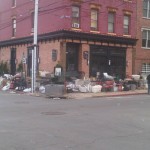 Saturday night at 8:15 Kristen and I were just finishing dinner, preparing to boil water to fill the bathtub, when the lights came on. We both gaped at each other for a moment or two. We didn’t expect to get power back that soon. Then, forty-five minutes later it went out again. Talk about a downer! Fortunately it came back an hour later, and we’ve had power since 10pm on Saturday night.
Saturday night at 8:15 Kristen and I were just finishing dinner, preparing to boil water to fill the bathtub, when the lights came on. We both gaped at each other for a moment or two. We didn’t expect to get power back that soon. Then, forty-five minutes later it went out again. Talk about a downer! Fortunately it came back an hour later, and we’ve had power since 10pm on Saturday night.
Yesterday Kristen cleaned out our bathroom supplies for extra soap, shampoo, toothpaste, and anything else we could donate to the temporary shelters in town. I cleaned out the storage unit Continue reading
Hanging out in (flooded) Hoboken
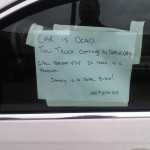 People have been incredibly nice and social since the power went out on Monday night. No crime that we’ve heard of here in Hoboken, but our day has taken on some aspects of a post-apocalyptic society (minus the zombies). We get up every morning and make coffee in the drip Mr. Coffee (heat water in pan, pour it slowly into the filter/coffee chamber, let it drain), cook whatever we need to for breakfast (finished the last of the eggs and bacon yesterday, just as the fridge finally gave up and stopped keeping things cold; we’re on steel cut oats from here on out), clean up a little, and then head out.
People have been incredibly nice and social since the power went out on Monday night. No crime that we’ve heard of here in Hoboken, but our day has taken on some aspects of a post-apocalyptic society (minus the zombies). We get up every morning and make coffee in the drip Mr. Coffee (heat water in pan, pour it slowly into the filter/coffee chamber, let it drain), cook whatever we need to for breakfast (finished the last of the eggs and bacon yesterday, just as the fridge finally gave up and stopped keeping things cold; we’re on steel cut oats from here on out), clean up a little, and then head out.
When we go out first thing our focus is what most others is: where is there still power, Continue reading
USS Chickasaw Part 7: Cutting Holes
The sheeting continues, but with the sheet for the main deck, it gets tricky. Holes for the turrets, the pilot house, and the stack have to be cut. Initially I drove myself nuts for a day or two trying to figure out the center of the circles, then realized that the camber of the deck makes the circles not entirely of the perfectly-round variety. An email to Dean, the designer, resulted in a template the the centers marked. I glued that to styrene, and away I went…
